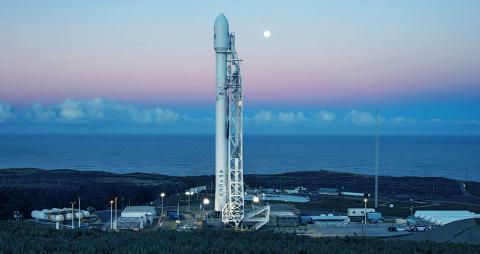The nation’s first domestically designed satellite, Formosat-5, is to be launched on Aug. 25 in the US to resume the observation missions of the decommissioned Formosat-2, the Cabinet said yesterday.
The satellite would collect data for natural disaster evaluation, national security, environmental monitoring, international rescue operations and scientific research, National Space Organization (NSPO) Director Chang Guey-shin (張桂祥) said.
Formosat-2 was decommissioned in August last year after being used in 343 disaster response missions such as providing authorities with immediate images of damaged areas during the Tohoku earthquake and tsunami in Japan in 2011, Chang said.

Photo courtesy of the Ministry of Science and Technology
The 450kg Formosat-5 is the first project in which the NSPO was fully responsible for all engineering, including payload, imaging sensors and ground control systems.
Formosat-5 is to carry the first locally made optical remote sensing instrument equipped with the world’s first space-grade metal oxide semiconductor image sensor, which the organization developed in cooperation with the nation’s electronics and semiconductor industries.
The satellite cost about NT$5.65 billion (US$186 million) to make and is to embark on a five-year observation mission around the globe.
The satellite’s launch was initially scheduled for October last year. A failed rocket test in September last year at SpaceX, the US company commissioned to launch Formosat-5, delayed the launches for all its customers, among which was the NSPO.
SpaceX is contractually required to pay 1.25 percent of the contract amount — about NT$700 million — for every month’s delay, Chang said, adding that the company is expected to pay 10 percent in compensation.
The Formosat-7 program, a follow-up Earth observation mission in which Taiwan is cooperating with the US National Oceanic and Atmospheric Administration, is to launch a constellation of 12 mission-specific satellites plus one NSPO-built satellite to perform radio occultation studies of the upper atmosphere, the NSPO said.
The first constellation of the Formosat-7 program, consisting of six satellites, is expected to be launched next year, the office said.

Eight restaurants in Taiwan yesterday secured a one-star rating from the Michelin Guide Taiwan for the first time, while three one-star restaurants from last year’s edition were promoted to two stars. Forty-three restaurants were awarded one star this year, including 34 in Taipei, five in Taichung and four in Kaohsiung. Hosu (好嶼), Chuan Ya (川雅), Sushi Kajin (鮨嘉仁), aMaze (心宴), La Vie by Thomas Buhner, Yuan Yi (元一) and Frassi in Taipei and Front House (方蒔) in Kaohsiung received a one-star rating for the first time. Hosu is known for innovative Taiwanese dishes, while Chuan Ya serves Sichuan cuisine and aMaze specializes

Taitung County is to launch charter flights to Malaysia at the end of this year, after setting up flights to Vietnam and Thailand, the Taitung County Government said yesterday. The new charter flight services, provided by low-cost carrier Batik Air Malaysia, would be part of five-day tour packages for visits to Taitung County or Malaysia. The Batik Air charter flight, with about 200 seats, would take Malaysian tourists to Taitung on Dec. 30 and then at 12:35pm return to Kuala Lumpur with Taiwanese tourists. Another charter flight would bring the Taiwanese home on Jan. 3 next year, arriving at 5:30pm, before taking the

Taiwan High Speed Rail Corp. (THSRC) plans to ease strained capacity during peak hours by introducing new fare rules restricting passengers traveling without reserved seats in 2026, company Chairman Shih Che (史哲) said Wednesday. THSRC needs to tackle its capacity issue because there have been several occasions where passengers holding tickets with reserved seats did not make it onto their train in stations packed with individuals traveling without a reserved seat, Shih told reporters in a joint interview in Taipei. Non-reserved seats allow travelers maximum flexibility, but it has led to issues relating to quality of service and safety concerns, especially during

An exhibition celebrating Taiwan and Japan’s comic culture opened on Saturday in Taichung, featuring a section that explores Taiwanese reproductions of Japanese comics from when martial law limited Japanese representation. “A Century of Manga Culture: An Encounter of Taiwan and Japan’s Youth” held its Taiwan opening ceremony at Taichung’s National Taiwan Museum of Comics after an initial one-month run in Japan’s Kyoto International Manga Museum between May 24 and June 24. Much like the Kyoto exhibition, the show mainly celebrates the comic connection between Taiwan and Japan through late Taiwanese comic book